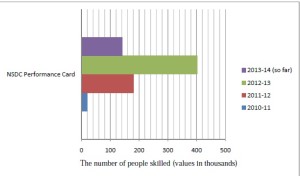
 National Skill Development Corporation (NSDC) was set up in 2009 with a mission to fulfill the growing need for skilled manpower across sectors in India. Dilip Chenoy, MD & CEO, NSDC, shares the journey so far and the future plans, in conversation with Chhavi Bakaria
National Skill Development Corporation (NSDC) was set up in 2009 with a mission to fulfill the growing need for skilled manpower across sectors in India. Dilip Chenoy, MD & CEO, NSDC, shares the journey so far and the future plans, in conversation with Chhavi Bakaria
How has been your journey at NSDC? How different is it from your work at Confederation of Indian Industry (CII) and the Society of Indian Automobile Manufacturers (SIAM)?
NSDC is a broader canvas. It is a little more complex than working for the automotive industry at SIAM. It is more or less going back to my days in CII where I used to handle 123 sectors under ASCON, so it is a tremendously challenging job. It is also fun as one gets to work with young people and requires travel. In SIAM travel meant Frankfurt, Seoul, Shanghai, or Geneva, but at NSDC it can be Mumbai or little known districts like Medak, which is on the outskirts of Hyderabad. I get to see more of India, but the best thing is that I get to meet many knowledgeable people, who have done a lot of work in the space of skill development, and the best part is working in partnership with them to transform lives of millions of people in India.
How successful has NSDC been so for in contributing towards government’s target of skilling 500 million Indians by 2022?
In total we have trained close to 7,45,000 people so far. In addition to this, we have imparted training to 100,000+ people under various government programmes. In the last three years NSDC has approved formation of around 92 training organisations that have a total capacity of training close to 12 million people a year, if they are on a full swing. So we have been successful first getting private sector to come and invest in skill development and second in terms of numbers. We have made a beginning, we are growing exponentially, but it’s a long way to go. In addition to that, another mandate that was given to us was the Sector Skill Councils (SSCs). So in the first year (2010-11) we had no SSC. Today, we have 23 SSCs approved and running. So we have been successful in creating a skill development ecosystem.
Please share NSDC’s experience with the Public Private Partnerships (PPP) model in the skill development space.
development space.
This is a very innovative model. If you look at Public-Private Partnership, it enables you to apply government-led initiatives to be delivered by the private sector. What is different about the NSDC model is that it’s not a grant model. It is a self-sustaining model. In fact the STAR scheme that we have launched recently in August 2013 is another model of taking a programme that is conceived as an incentive, and delivering it through PPP model, which is private sector led and involves the industry.
“There is a huge need to actually work with engineering students because the number of students who find a job after completing engineering is very miniscule”
Currently, how many private partners are working with NSDC? How do you keep a performance check?
We approved 87 partners in the last Board meeting and this number is expected to go up to 92. We have approved 23 SSCs. 12 SSCs are active currently, but now because the STAR programme, all have become active. The interesting part is that we have a three to four years funding mechanism. The first bunch is disbursed when the partners meet some pre-disbursal conditions. However, the second bunch is disbursed when they achieve milestones. So what we find is that initially a lot of companies over-project their initial targets. Thus instead of taking the second bunch in six months or one year they take it after one year or 18 months. But most of the companies have met their first year targets, maybe extended but nine to 10 of our partners are meeting the targets year after year. Some of the partners are meeting the placement percentages also, slowly and steadily. For instance, if we take the three-year old partners, most of them have stabilised, some are doing smaller numbers, but they have stabilised and they are making surpluses. Two-year old partners are in the process of getting surplus. The one year old partners are learning from the experience of two and three years old partners. So it’s a learning process. One or two partners have not done well, but that’s rare.
How important is it to integrate vocational skills into mainstream education especially in context of the engineering education? The integration of vocational and mainstream education in India is a must to bridge the skills gap. There is a huge need to actually work with engineering students because the number of students who find a job after completing engineering is very miniscule. It is the competency of the people we wish to improve. Now competency has three aspects – skills, knowledge and attitude. Knowledge and attitude is what the education system normally provides. So the skills are what one either learns on the job or one takes up a separate course. So for all types of people, school dropouts, college students or engineering students, at all these levels there are different types of interventions possible that can enable them to bridge the divide between the world of education and the world of work.
How do you see the skill development sector performing in the coming years and what targets has NSDC set for itself?
NSDC has hiked its current year’s target to about one million as compared to that of 400,000 last year. The estimate is that the skills development sector has an annual turnover about a USD 20 billion. Given the fact that we need to skill 500 million people and we are looking at 6000 to 60,000 companies either already working or planning to work in this space, so it is going to expand. It is one of the few areas in today’s bleak economic scenario, which requires investment and has a growth of upwards of 25 percent, and gives you fairly decent return on investment when you get the right business model.






















